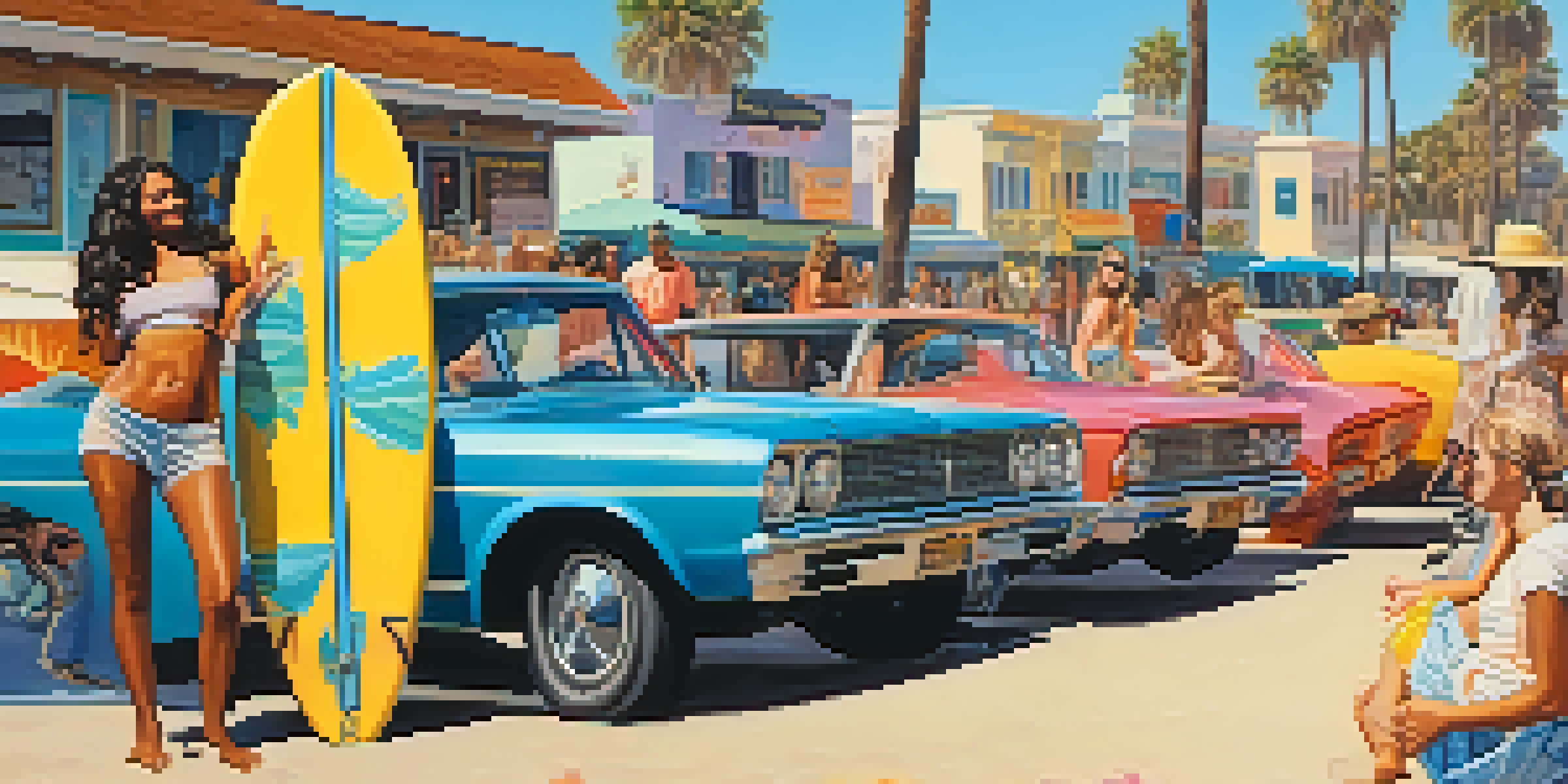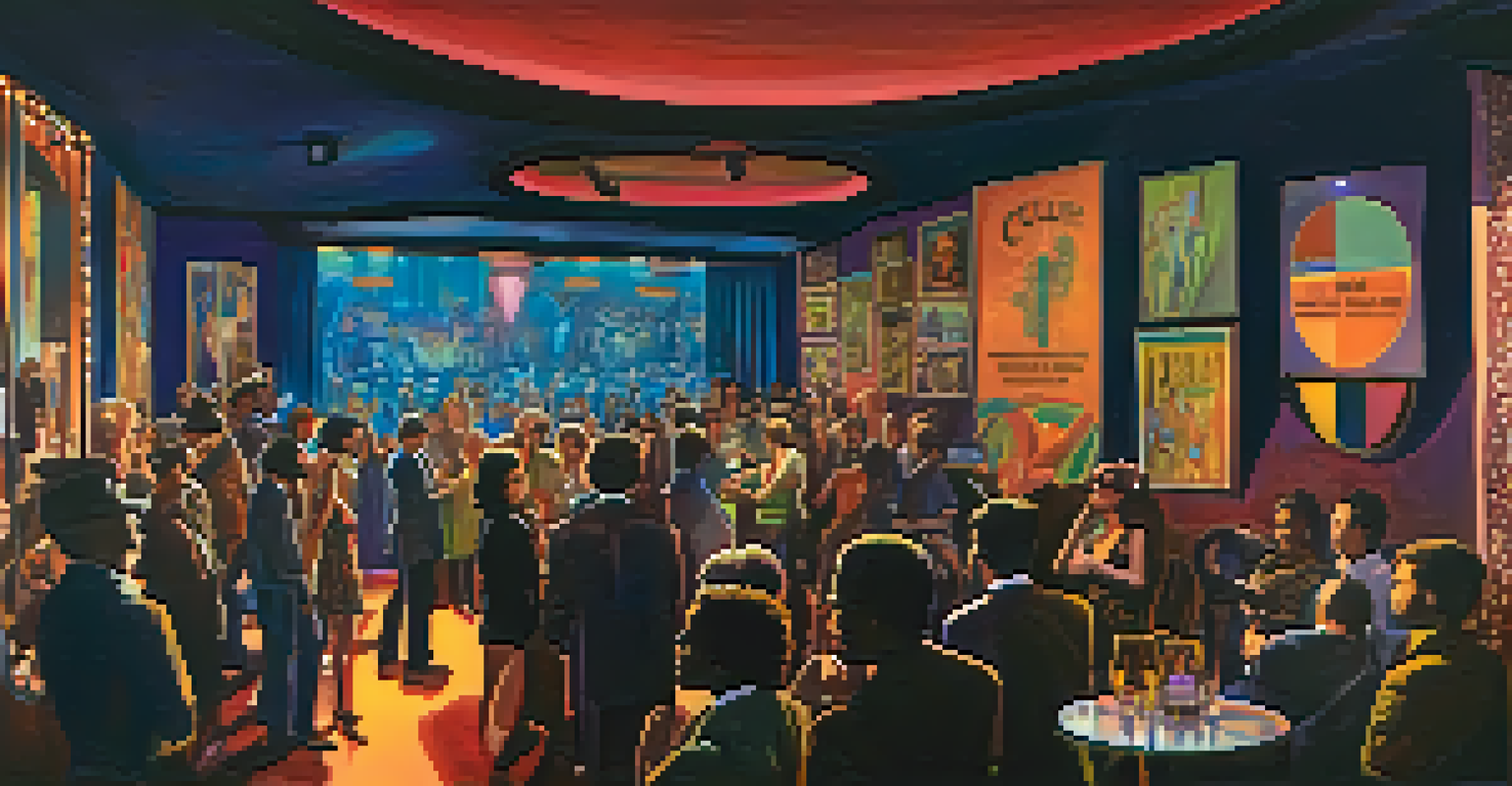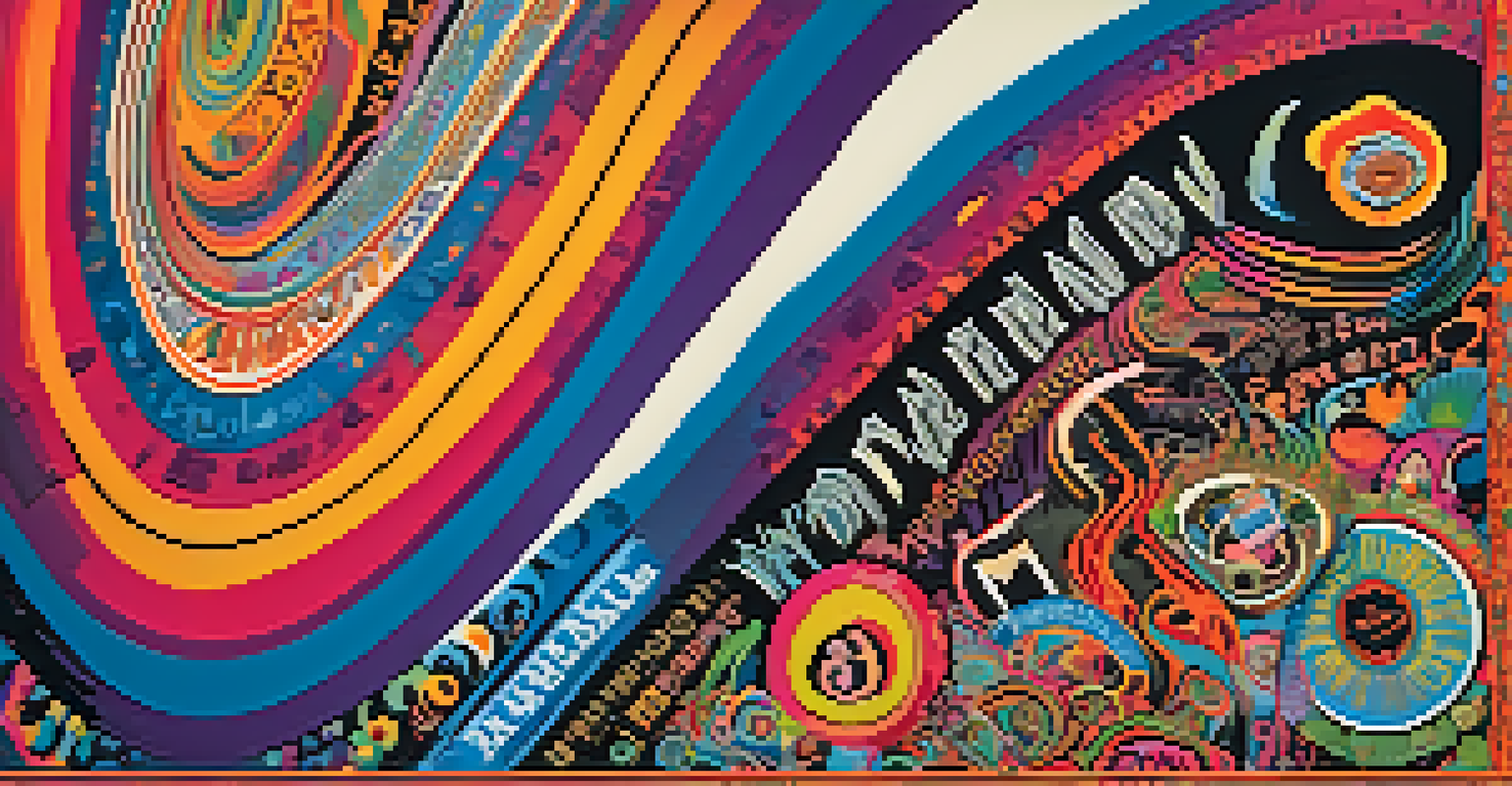Counterculture and Nightlife: LA in the 1960s Revolution

The Rise of Counterculture in 1960s Los Angeles
In the 1960s, Los Angeles became a hotbed for counterculture, challenging mainstream values. The city, with its sun-soaked beaches and diverse communities, attracted young people seeking freedom and self-expression. Movements like the Civil Rights Movement and anti-Vietnam War protests inspired many to rethink societal norms, creating a fertile ground for revolutionary ideas.
The most important thing is to be true to yourself and those around you.
As the decade unfolded, this burgeoning counterculture found its voice in music, art, and fashion. Iconic artists like The Doors and Jefferson Airplane emerged from the vibrant local music scene, while visual artists experimented with psychedelic themes. The fusion of these artistic expressions became a rallying point for those seeking change and a new lifestyle.
This cultural shift also encouraged communal living and alternative lifestyles, with many embracing the idea of peace, love, and unity. LA's neighborhoods, from Venice Beach to the Sunset Strip, became hubs for this new way of life, drawing in those disillusioned with the status quo.
The Beat Generation's Impact on LA's Nightlife
The Beat Generation laid the groundwork for the counterculture movement in LA, influencing the city's nightlife in profound ways. Writers like Jack Kerouac and Allen Ginsberg championed a lifestyle that celebrated spontaneity and artistic expression, paving the way for a more liberated social scene. Their works inspired countless individuals to explore jazz clubs, poetry readings, and underground parties.

Venues like The Troubadour and The Ash Grove became hotspots for budding musicians and poets, offering a platform for self-expression. These spaces thrived on the energy of the Beats, creating an atmosphere where creativity and rebellion flourished. The blending of literary and musical performances turned nightlife into a revolutionary act.
Counterculture Thrived in 1960s LA
Los Angeles became a vibrant hub for counterculture, where music, art, and communal living flourished, challenging mainstream societal norms.
As the Beats mingled with the rising counterculture, the nightlife in LA transformed into a vibrant tapestry of art and activism. This fusion not only shaped local entertainment but also echoed through the broader cultural landscape of America.
Psychedelic Music and its Role in LA's Counterculture
Psychedelic music became synonymous with the counterculture movement in Los Angeles during the 1960s. Bands like The Byrds and The Grateful Dead pushed musical boundaries, incorporating experimental sounds and lyrics that reflected the ethos of the time. This genre captured the spirit of exploration and mind expansion that many young people were seeking.
You can't change the world, but you can change yourself.
The Sunset Strip was particularly influential, serving as a stage for legendary performances that drew crowds from all walks of life. Concerts became communal experiences, where attendees would dance, connect, and share ideas, embodying the movement's ideals. These gatherings not only entertained but also built a sense of belonging among those fighting for change.
Psychedelic music did more than entertain; it became a soundtrack for the revolution. Songs often addressed social issues, encouraging listeners to question authority and embrace individuality, further solidifying music’s role in the counterculture.
Art and Visual Expression in 1960s LA
The visual arts in 1960s Los Angeles mirrored the upheaval of the counterculture, showcasing a vibrant palette of colors and ideas. Artists like Ed Kienholz and Robert Irwin pushed the boundaries of traditional art forms, creating immersive experiences that challenged viewers’ perceptions. Their work often reflected the social and political turmoil of the era, making art a vehicle for commentary.
Psychedelic art, characterized by swirling colors and surreal imagery, became hugely popular, often seen in concert posters and album covers. This visual language aligned perfectly with the music scene, creating an aesthetic that was instantly recognizable and widely embraced. Galleries and exhibitions began to feature this new genre, bridging the gap between artists and the community.
Psychedelic Music Shaped a Movement
Psychedelic music in LA not only entertained but also served as a powerful soundtrack for social change, encouraging individuality and questioning authority.
Art became a vital part of nightlife, with venues showcasing experimental works alongside live music. This fusion of art and entertainment created a unique cultural experience, allowing audiences to engage with the revolutionary spirit of the time.
Fashion Trends: A Reflection of Counterculture
Fashion in 1960s Los Angeles was a vibrant reflection of the counterculture movement, turning sidewalks into runways of self-expression. Young people embraced colorful clothing, tie-dye fabrics, and bell-bottom jeans as symbols of their rebellion against conventional norms. This shift in style was more than just a trend; it represented a desire for freedom and individuality.
Boutiques like Melrose Avenue's vintage shops became hubs for fashion-forward thinkers, offering unique pieces that allowed for personal expression. The influence of music and art on fashion was palpable, with bands often setting trends that fans eagerly adopted. This interconnectedness created a dynamic cultural scene where style played a key role in shaping identity.
The bold fashion choices of the time also served as a statement against the conservatism of the previous decades. By embracing unconventional looks, individuals were not only making a personal statement but also participating in a larger dialogue about societal change.
The Influence of the Anti-War Movement on Nightlife
The anti-war movement significantly shaped the nightlife of Los Angeles in the 1960s, drawing attention to social justice and activism. As young people rallied against the Vietnam War, many sought refuge in cafes, bars, and music venues that embraced their ideals. These spaces became sanctuaries for discussion, protest, and connection, fostering a sense of community among like-minded individuals.
Events like peace rallies and benefit concerts often spilled over into the nightlife scene, transforming ordinary outings into acts of resistance. Venues hosted performances that directly addressed the war, giving artists a platform to voice their dissent. This interplay between activism and nightlife allowed participants to channel their frustrations into creative expression.
Legacy of Activism in LA Nightlife
The anti-war movement deeply influenced LA's nightlife, turning venues into spaces for activism and community, a legacy that still resonates today.
The anti-war sentiment also influenced the ambiance of local hangouts, where discussions about politics and peace were as common as music and art. This blend of nightlife and activism underscored the importance of community in the pursuit of social change.
Legacy of 1960s Counterculture in Today's LA
The counterculture and nightlife of 1960s Los Angeles left an indelible mark on the city's cultural landscape, influencing generations to come. Today, LA continues to be a melting pot of creativity and expression, with its roots in the revolutionary spirit of the 60s. Modern artists, musicians, and activists often draw inspiration from this era, keeping the flame of change alive.
Many of the venues that thrived during the 1960s have evolved but still celebrate the same ideals of community and self-expression. New generations flock to these spaces, finding resonance in the messages of peace and love that defined the counterculture. This continuity reflects a city that honors its past while looking towards the future.

The legacy of the 1960s counterculture serves as a reminder of the power of collective action and creative expression. As Los Angeles continues to navigate social and political challenges, the spirit of the 60s remains a guiding force for those committed to making a difference.